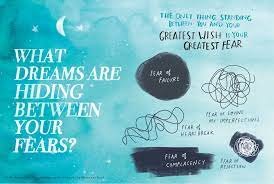"What If I Can't Do It?" Four Steps to Facing Your Fears
A page taken from My Friend Fear, my friend Meera Lee Patel’s beautiful book.
This past week I met with a client I hadn’t seen in a few months. She is working on a business that is right up my alley — mission-driven, creative and with the potential to make a real impact. From my perspective, she has exactly what it takes to bring her vision to reality.
As we were wrapping up work on the next steps leading up to her big launch, she confessed that there was something else on her mind, something that was keeping her up at night...
“But what if I can’t do it?”
Ha! There it was, rearing its ugly head…Seth Godin calls it the Lizard Brain. Steven Pressfield calls it the Resistance. Others call it by its more familiar name — good old fear. Inescapable, prolific, persistent fear.
Fear distracts you when you’re making a progress on a big idea or project you’re working on. Fear interrupts when you’re about to discover a personal revelation that will alter your course. Fear bangs on the door at 2 am when you are busy making brave decisions that will change your life.
Fear is what shows up when you are on the verge of a breakthrough.
I’ve learned that before we can grow into who we are meant to be, we have to be aware of all the beliefs we have that can hold us back. We have to clearly know and understand our fear, so that when it shows up, instead of running or retreating, we can say, “oh, here you are again”.
Sometimes fear can be stealthy. It shows up as irritation, procrastination, anxiety or self-doubt. It shows up through underperformance at work, conflicts in your relationship or unhealthy choices.
Our relationship with fear is ongoing. It will never completely leave us nor should it — it does serve us well at crucial times. But if it shows up just when you are about to grow, build or create, it is the right time to take a hard look at it and ask, “Really, here again?” So how, as my friend and author Meera Lee Patel says, do you make fear your friend?
Here are the four steps I use to face my fears:
Start by writing them all down. Every single one. Write, Things I’m Afraid Of at the top of the page and don’t stop writing until you are done. It is very likely that “what if I can’t do it?” will be at the very top, followed closely by, “am I good enough?” and “who am I to do this?” I wrote some of these statements down myself less than a month ago.
Choose your top 3 strongest fears. Next, write down a response to each fear. For example, next to “What if I can’t do it?”, you could write, I’ve accomplished X, Y and Z in my life, without knowing beforehand if I could do it yet I did. Why would this be any different?” Or as Mindy Kaling says, “Why Not Me?” If you have trouble coming up with a response, think about what you’d say to a dear friend who came to you with these same fears. Or what I often do is connect with a trusted friend or mentor who can help address these fears with you.
Imagine how you will feel when you’ve accomplished your goal or overcome your fear. This is the fun part — allow yourself to feel right now what it will feel like when your vision is realized. You can do this through journaling, or by drawing a picture of your vision, or while sitting on a park bench or your meditation pillow. Give yourself the time to really imagine what living in your future feels like. It may feel silly at first but everyone from successful entrepreneurs to athletes to keynote speakers uses this tool. Imagine that you’re living in the vision for your future, not where you are currently. How will you feel then? This exercise always invigorates and energizes me!
From this place, take the next step. Avoid making decisions or taking action while you’re in the fear mindset. When we act from a place of fear, we’re not standing in what’s true for us. Instead, we’re standing in what’s true for our fear. Your actions based on your fear will be smaller, more risk-averse, and anxiety-provoked (in all areas of your life!). When you feel empowered, strong and capable (which means to have the ability, fitness, or quality necessary to do or achieve a specified thing (notice the definition does not include knowledge- you can always attain that!)) you’ll make more powerful decisions and take stronger, more definitive action.
When you have an idea that excites you, that brings you hope and that sparks your enthusiasm, expect fear to not be too far behind. If we expect it, we can learn to listen to it. We can give it a chance to have its say. And then we can say, “Thank you. Now good-bye!”.
“Everything you want is on the other side of fear.”― Jack Canfield
With love,
Kena xo
Kena Paranjape, Founder, All You Are

